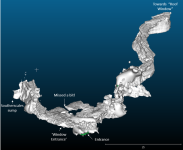Subpopulus Hibernia
Active member
You can read more on the Caveatron here - http://caveatron.com/index.html
It's quite a sophisticated device, it does the usual compass, inclination, and length measurements, but it's primarily a handheld 3D scanning tool.
I'm not sure how well it would replace or succeed the DistoX - it looks quite techy to assemble and set up and is about 3 times the size of the DistoX. The beauty of the DistoX was that it is a relatively simple tool, that can be fairly easily produced and assembled - which is why there's so many of them. In terms of producing devices, most of the other cave surveying tools I've seen are of fairly limited scalability and won't reach the level of ubiquity that the DistoX had.
It's quite a sophisticated device, it does the usual compass, inclination, and length measurements, but it's primarily a handheld 3D scanning tool.
I'm not sure how well it would replace or succeed the DistoX - it looks quite techy to assemble and set up and is about 3 times the size of the DistoX. The beauty of the DistoX was that it is a relatively simple tool, that can be fairly easily produced and assembled - which is why there's so many of them. In terms of producing devices, most of the other cave surveying tools I've seen are of fairly limited scalability and won't reach the level of ubiquity that the DistoX had.



